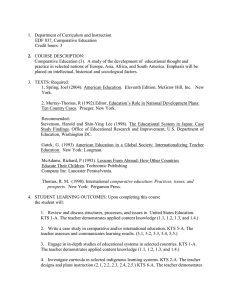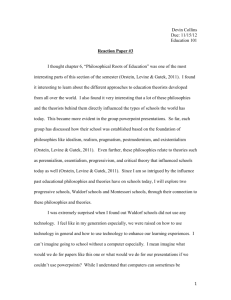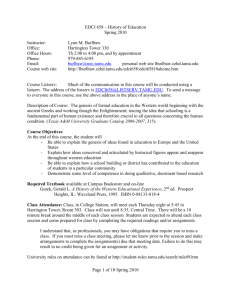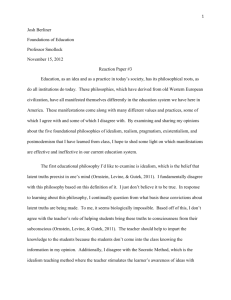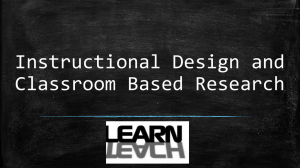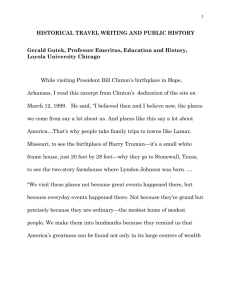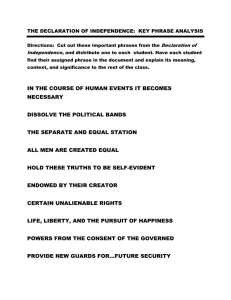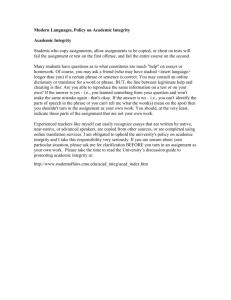International Education Definition Quiz
advertisement
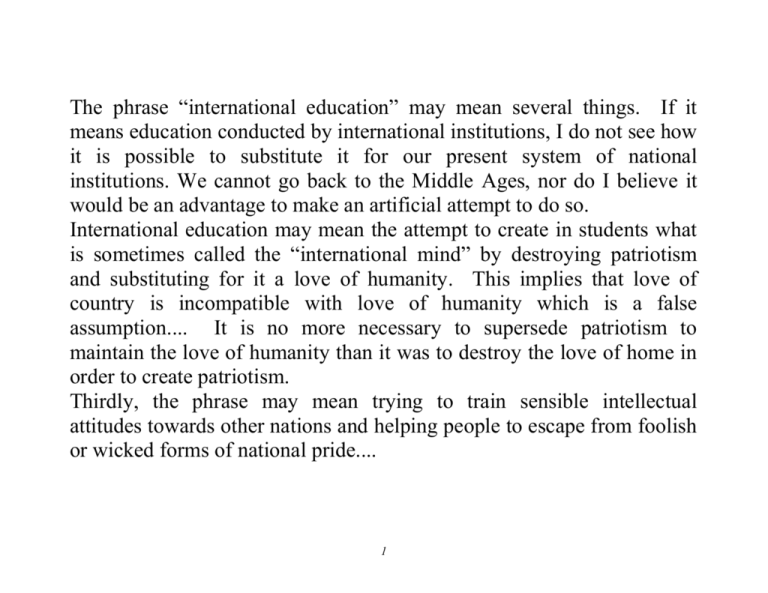
The phrase “international education” may mean several things. If it means education conducted by international institutions, I do not see how it is possible to substitute it for our present system of national institutions. We cannot go back to the Middle Ages, nor do I believe it would be an advantage to make an artificial attempt to do so. International education may mean the attempt to create in students what is sometimes called the “international mind” by destroying patriotism and substituting for it a love of humanity. This implies that love of country is incompatible with love of humanity which is a false assumption.... It is no more necessary to supersede patriotism to maintain the love of humanity than it was to destroy the love of home in order to create patriotism. Thirdly, the phrase may mean trying to train sensible intellectual attitudes towards other nations and helping people to escape from foolish or wicked forms of national pride.... 1 Fourthly, the phrase may mean special instruction give in international law, the history of diplomacy, or other topics concerned directly with international relations... (Dr. Paul Van Dyke cited in Harley 1931, p 15) Everywhere nationalism is a potent force, and there is still fear lest too much emphasis upon education for a world society result in minimizing education for national citizenship... The one phrase which various nations seem to be willing to use is “education for international understanding” as attested to by the adoption of this phraseology by UNESCO after long and heated debates. These words imply a less ambitious approach and one which most governments are willing to approve. 2 (Leonard Kenworthy, 1951 in Education for a World Society, p 200) Kenworthy (1951, pp 208-215) recommends a series of eight conceptual areas which could be translated into aims of education for a world society which itself could be viewed as a proposed definition of international education: 1) the ideal of a world society 2) information on peoples and nations of the world 3) interrelationship and interdependence of nations 3 4) institutions of a world society 5) insight into national life in relation to the world society 6) identification with the world society 7) interpretation of information 8) improvement in the art of group living Scanlon and Shields (1968, pp xiii-xix) propose a three part schema for the organisation of the activities that ‘international education’ in the United States embrace. The proposed framework was; 4 Promoting a Self-Image Abroad Promoting International Understanding and World Peace Promoting Human Knowledge and Competence International education is generally defined as “the various types of educational and cultural relations among nations”[reference to a US government report of 1959]..... This definition accounts for most of the activities in the field; however, it does not incorporate all. For example it blurs the important distinction between the roles of the practitioner and the theorist... In effect, then, this definition does not do full justice to international education as an evolving academic field for the study of transmitting and fostering beliefs, skills, attitudes, and knowledge across national boundaries... 5 Thus, learning experiences that take place merely because an individual is in a particular place at a particular time are not defined as education. In the context of this definition, the unintentional acquisition of learning by an individual does not qualify as international education. The value of applying this narrower definition to the field of international education is that it clearly separates the field from the broad, formless, and almost limitless areas of acculturation and general cultural contacts. In addition, it establishes reasonableness and order at a time when the field is burgeoning. Far too large a proportion of the current literature consists of breezy travelogue, sentimental reminiscence, or pamphleteering for a favored cause or project - and far too little concentrates on the specific processes of systematically educating individuals along national frontiers. (Scanlon and Shields 1968, Introduction, pp x-xi) What are the various types of educational relations among nations? Since international education can be traced to antiquity, it would seem that the literature of the field would 6 provide a excellent starting point for resolving the question. However, the state of the documentation is such that there is little accessible material for the period before World War II and too much material for the material after the war to handle easily. Both periods present the serious scholar with complex research problems. The research problem is intensified because so few historians are interested in international education. Thus, even where documents do exist, there has been almost no one to synthesize their contents. At the moment, there is no general history of international education, and data have to be sought in a variety of widely scattered sources. Consequently, the field of international education does not have at its command historical studies to fix the lineage, design a fitting methodology, or define its content. Because international education has not had the benefit of self-examination in the perspective of history, it has been hindered from developing into a bona fide field of study. (Scanlon and Shields 1968, Introduction, p xii.) Lineage.....How does the history of international education inform our present modelling, 7 planning, research and practice in international education? Methodology..... What is the most appropriate methodology for investigating international education and what learning and teaching methodologies are most appropriate in the field? Content.....What common human values and traditional areas of study are most suitable for inclusion within the field of international education? 8 In his teacher-training text, American Education in a Global Society: Internationalizing teacher education, Gutek (1993) identified a series of academic disciplines and activities which have, over the past century been related directly or indirectly to what has been known as ‘international education’. Gutek’s list included; Comparative Education Foreign Policy Studies Regional or Area Studies International Development and Development Education Peace Education International Exchange Program Global Education International Business Education 9 Education for the multinational or transnational business corporation is yet another form of international education. This rapidly growing area of economic activity involves economics, management, advertising and marketing. It represents the involvement of worldwide corporate financial interests and conglomerates. Educators associated with international education have often overlooked the importance of this new form of international business or tend to see its profit-making objectives as contrary to the more altruistic motives associated with peace education or global education. However, the multinational corporation has been a force for creating greater economic interdependency. It should be considered a contributor to the dynamics of a new kind of world economy.... 10 (Gerald Gutek, 1993, p 30) Gerald Gutek provides one of the few examples of an attempt to stipulate a definition of international education in his 1993 teachertraining text. He detailed international education as education that examines: 1) the informal, nonformal, and formal relationships among peoples of various nation-states; educational 2) those issues that are global in nature and transcend national boundaries; 11 3) the emergent trends that are creating greater interdependency and interrelationships among people as members of a global society. Gutek then goes on to explain the thinking behind the construction of such a definition; Such a definition avoids the egocentrism of the older, nationalist view of education. It also avoids the “wishful thinking” of those who take a view of international education that neglects the reality of the nation-state. It is both content and problem centered. While considering the impact of historical forces, it also anticipates the emergence of new economic, political, social, and educational configurations. It recognizes the reality that we are all both 12 citizens of nation-states and participants in a global society. It further recognizes that there are and will be inevitable tensions between these two ideational foci of our lives, but also that there are many creative possibilities that grow out of this tension. (Gutek 1993, pp 33-34) In general, new educational proposals for the global economy include lifelong learning, learning societies, international and national accreditation of work skills, multiculturalism, 13 international and national academic standards and tests, school choice, and economic nationalism. (Joel Spring, 1998 in Education and the Rise of the Global Economy, p x) 14

